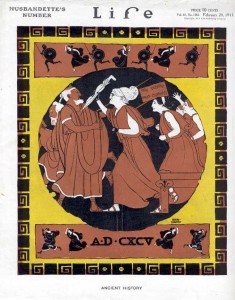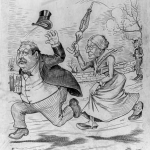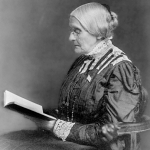
Rea S. Irvin (1881-1972)|Ancient History, 1912|Cover illustration for Life v. 61, no. 1582 (February 20, 1913)|Ink, gouache, and opaque white on board|Library of Congress, Prints and Photographs Division, Art Wood Collection of Caricature and Cartoon, unprocessed item
The cover illustration for the February 20, 1913 issue of the humor magazine Life, is titled “Ancient History.” It is a single panel cartoon, drawn in the style of a Greek vase decoration, red on black. At the center of the circular illustration is the image of an older woman with grey hair dressed in a flowing Doric chiton (a single length of fabric folded, wrapped, and pinned), poking a startled man dressed in a toga (an elder statesman perhaps) in the chest with an umbrella ferrule. The central woman is a caricature of Susan B. Anthony. Compare the caricature to two other images of the suffragette below: the first is a typical photo of Anthony in her old age seen in profile wearing her glasses and reading. As we can see, Susan B. Anthony typically wore her hair pulled back into a tightly constructed bun. The caricature of Anthony displays a larger and looser bun shown in the style of the ancient Greek women who wore their buns in a more elaborate up-do with the hair wrapped up and away from the back of the head.

Charles Bartholomew (1869-1949)|Cartoon of Susan B. Anthony Chasing President Grover Cleveland, c. 1892-96|Library of Congress, Prints and Photographs Division; Reproduction Number LC-USZ62-96565
The second (above) is a political cartoon from between 1892 and 1896. It shows President Grover Cleveland, carrying book titled “What I know about Women’s Clubs,” being chased by Susan B. Anthony brandishing a “Women’s Suffrage” umbrella in her right hand, as the figure of Uncle Sam stands laughing in the far right background. She is chasing after President Cleveland in her fight for women’s right to vote. It is this cartoon that leads us to understand that frowning image on the Life cover is meant as a caricature of Anthony and the inclusion of the umbrella used as a prod or a goad has a precedent in the earlier political cartoon. For this Life cover, the illustrator, Rea Irvin, covered Anthony’s hands in contemporary black lady’s gloves, which creates an interesting juxtaposition to the Grecian garb. There is an fascinating aside with respect to the use of the umbrella in Irvin’s image: in ancient Greece ladies of fashion commonly carried a parasol with them. The character Prometheus in Aristophanes’ Birds, uses a parasol as a comical disguise, because it was considered an article of female use.
In the Life magazine cover Susan B. Anthony’s character is followed by other women, one of them carrying a sign that says, “We Want Our Rights.” As the background group of women move into the scene, behind the foreground gentleman, the rest of the men are seen running away. The decorative friezes above and below the central portion of the illustration include more figures of Grecian women chasing after Grecian men wearing their togas or Grecian soldiers protected by their shields. The illustration’s edge, comprised of a modified Greek key design, reinforces the references to ancient Greece.
Susan B. Anthony was one of the leaders of the American women’s rights movement in the nineteenth century, focusing not only on suffrage, but on economic, social, and legal rights as well. When she died in 1906, women had still not yet won the right to vote. With the ratification of the 19th Amendment in 1920, women finally received the right to vote . The Life cover includes the legend, “A.D. CXCV” at the bottom of the picture. The date is 1905 in Roman numerals, the year before Anthony passed away of heart disease and pneumonia.
Above the illustration on the cover is a notation to the left that this issue of Life magazine is the “Husbandette’s Number.” The term husbandette was coined a month prior to the issuing of this cover, by the cartoonist and creator of Gasoline Alley, Frank O. King (1883-1969). On January 9, 1913 King introduced a series of single-panel gag cartoons beginning with a page headed, “Hints to Husbandettes.” A husbandette was the spouse of a suffragette; the term implied that the husband’s support was grounded in a desire for domestic peace.
July 29, 2010
By Joyce K. Schiller, Curator, Rockwell Center for American Visual Studies
Norman Rockwell Museum







